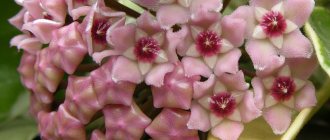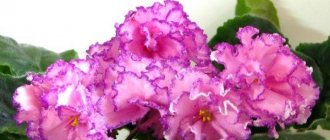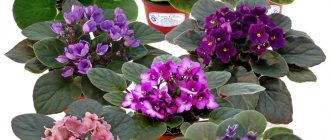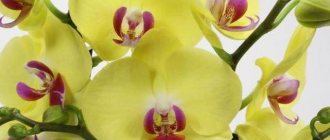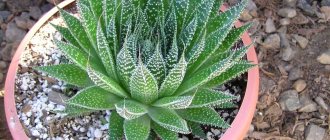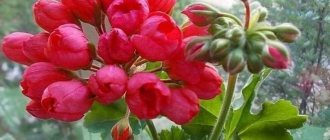This Saintpaulia variety was bred in 2010 by Elena Lebetskaya, a representative of Ukrainian breeders living in Vinnitsa.
Each plant bred by her has the prefix LE in its name, which is an abbreviation of her last name and first name. So, the correct name of the plant is Saintpaulia “LE - Chateau Brion”. Dear readers! For you, we have created communities on social networks in which useful articles and interesting ideas are published several times a day! Subscribe and receive useful content in a convenient format!
Violet Le Chateau Brion
At the beginning of her career, Elena was not a breeder, she was only involved in collecting various flower varieties and growing Saintpaulia. Only at the beginning of the 21st century did I try for the first time to breed new varieties. This is the prehistory of the famous Le Chateau variety.
Flowers of this species are erect and have a dense structure. Their visual perception seems much more powerful than that of most representatives of their genus. The leaves are very similar to other species, but have some differences: their color is more saturated and bright, their shape is slightly elongated, and the structure of each leaf has a corrugated surface.
The buds that appear will pleasantly surprise you with their rounded shapes and diameter, which reaches 6 cm. The flower petals have a terry surface and a deep dark ruby color. Along the edge of each petal there is a border, mostly white. Much less commonly, the white border has a greenish tint.
Proper fulfillment of all conditions for growing violets is the only and sure way to ultimately get a healthy and flowering plant.
Flowering of standard violets EK-Exotica, LE-Macho, LE-Chateau Brion and others.
Hello, forum members and site guests. Today I will show you the flowering of my standard violets. Most of the standards live on my windowsill in natural light. And now, at the beginning of summer, my window sills turn into flowering meadows.
I’ll start the show with a variety that I don’t often see in collections - this is the Korshunova variety EK-Exotica . “Terry soft pink flowers-buds with a wide purple-red border and a bright light green fringe. Bright exotic flowers! Neat exhibition rosette. (Description by the author)
I purchased this variety as a child at the very beginning of the formation of my collection. The purchase was, as they say, at random. I wanted something pink with a green ruffle. I chose from several varieties in the DF and, for some reason, they advised me to take the baby of this particular variety. She sat with me for quite a long time and grew slowly. I didn't pay much attention to her. And this winter I waited for the first flowers. Unfortunately, I didn’t take a photo then, because the flowers didn’t impress me at all, although they corresponded to the description. But this spring the violet blossomed and began to produce peduncle after peduncle. And it turned out to be almost a cap flowering:
The flowers of this variety are a very delicate light pink color with a bright dark pink-lilac border-spray, and along the edges of the petals there is an intermittent green ruffle.
Flowers last a very long time. Here's another photo of the flower.
The peduncles are a little long, but the abundance of flowers completely compensates for this shortcoming. This violet bloomed for me from March to early May. And when I was about to write this article, it bloomed again with larger and more double flowers.
I read somewhere that EK-Exotica is a capricious variety. My specimen turned out to be not capricious at all, I would even say completely unpretentious. I can’t say anything about the “neat outlet” (as described by the author), because... I had this outlet where I had a little free space. As a result, she turned out to be quite “shaggy”.
Next - LE-Macho . According to the flower description: “Very large semi-double burgundy-violet-black stars with a clear white wavy border.” Here's my version:
It turned out to be a chimeric sport! I really liked this option. The LE-Macho variety was purchased along with other varieties whose flowers are burgundy-violet-blue in color with a white or greenish border - I had such a period. And I’m very glad that such a sporty chimera bloomed in me, and not a varietal purple flower with a white border. This is the case when you enjoy the sport more than the variety.
The flowers are very large (up to 7 cm) in the shape of a star. Unfortunately, they don't last long. Flowers bloom sequentially, so it’s impossible to get a photo with a lush head of flowers - a fading flower is sure to get into the lens and spoil the whole picture. The positive thing is that the variety is unpretentious and blooms constantly.
The next variety from the “burgundy-violet” series: LE-Chateau Brion (Lebetskaya) “Large double dark wine-ruby velvet stars with a thick, slightly corrugated white border on good strong peduncles. Abundant flowering. The green leaves are slightly wavy and elongated. Neat outlet."
I can’t boast of cap flowering - the peduncles are a bit long. At the same time, the flowers are very spectacular.
And a close-up of the flower:
The socket is pretty neat
The outlet is still young. There were no hassles or problems when growing this variety. We will grow up and strive to bloom in a bouquet.
And this is the “sister” of LE-Chateau Margaux - a recognized sport from the LE-Chateau Brion variety.
This outlet is truly the “sister” of LE-Chateau Brionu shown above. They grew from one leaf! These are the wonders of nature. The flowers at Chateau Margot are very large and double. White with greenish lower petals. And in some flowers the center is slightly tinted with a bluish-lilac color.
The socket is very neat and compact. Blooms constantly. Flowers last a very long time. This rosette stands on my windowsill in natural light, and it bloomed all winter.
And now a head of flowers from the industrial chimera Myrthe (Humako). I found this description of this chimera: “Industrial chimera has all the qualities of Saintpaulia varieties grown on an industrial scale. Dark green quilted, rounded foliage, easily forming a show-quality rosette, harmoniously combines with a lush bouquet of snow-white pansies with corrugated petal edges, along the center of which there are bright radial fuchsia stripes.”
A very bright openwork head of flowers on a symmetrical, neat, but rather large rosette:
I rested all winter. And in the spring it gained strength and bloomed with a gorgeous bouquet. Here's a floral carpet.
Like many industrial violets, they are not capricious.
And another violet with ruffles, Rosie Ruffles (D.Harrington) “Single or semi-double light fuchsia star with a light, heavily lacy edge, tall strong peduncles, medium green foliage, well pubescent, wavy.”
“Pink ruffles” - the name of the variety speaks for itself. Very “fluffy” flowers of a deep pink-fuchsia color. Very lush flowering.
This variety was recently shown by Alena Buryakova. Our sockets are “sisters”. This variety has a very even, neat rosette. But there is one drawback - the rosette quickly gains leaf mass. The stem lengthens and the heavy rosette begins to sway in the pot. Otherwise, the variety is unpretentious and easy to care for. And besides, it pleases with constant abundant flowering.
Well, this is where I’ll end the show. I wish everyone a pleasant viewing.
Selecting suitable soil
The land for growing the Le Chateau variety must be correctly selected. This plant variety will feel most comfortable only in acidic soil, with a certain content of peat and sand.
The purchase of such land can be made in a specialized flower shop or done with your own hands, adhering to the following proportion:
- earth with a certain acid content - 5 parts,
- peat - 3 parts,
- sand - 1 part.
Charcoal will also be useful in the soil composition. But, its content should not exceed 10% of the volume of the planting pot. In order for moisture to evaporate less, it is better to mix peat with vermiculite. It is also worth taking care of regular and high-quality feeding of the plant.
It is especially necessary for the normal course of the growth process. Feeding should be different: in autumn and spring it should be mineral, and in winter only a humate solution.
Growing the variety
Correct growing conditions are the key to flower health; let’s take a closer look at the basic rules.
Earth
To properly grow the variety, you need to choose good soil.
Saintpaulia requires an acidic composition with leaf soil, peat and sand.
Their ratio is 5 to 3 to 1, respectively.
It is advisable to add charcoal or dried moss, but not more than 10% of the volume.
To retain moisture, it is recommended to mix peat with vermiculite. During the growth process, feeding is necessary.
In spring and autumn - mineral, in winter - with humate solution.
Plant container
When choosing a container, there are several points to consider:
To protect against acidification, you need to let the roots grow. Since the plant is small, it is enough to start with a glass with a diameter of 6 cm.- For an adult Saintpaulia, a small pot with a diameter of at least 10 cm and a height of 12 cm is sufficient.
- There should be a drainage filler at the bottom. The drainage hole must be large enough.
- The first inflorescences are formed after the roots grow throughout the container.
- Chateau Brion requires replanting every year. It is enough to change the soil, while the container may remain old. Use caution, especially when cleaning the roots.
What kind of lighting is needed?
Saintpaulias love light.
LE "Chateau Brion" is no exception, but it should be taken into account that direct sunlight in the warm season will have a negative effect. In total, the violet should spend more than half the day in light.
The best option would be a window sill with windows facing north or northwest. Any other option is possible, but the light should be diffused, for example with dark curtains. In winter, it is necessary to supplement natural lighting with artificial lighting.
Important! Violets are unpretentious, so they can be grown indoors without access to sunlight, under artificial lighting.
Temperature
Saintpaulia does not develop well at low air temperatures.
The most optimal temperature for adult plants is 20-25 degrees Celsius, and for young plants - 22-24 degrees. It is advisable to maintain this temperature daily.
In addition, flowers do not tolerate sudden changes in temperature and wind, so you should be extremely careful when ventilating rooms.
Humidity
"Chateau Brion" is moisture-loving, so it is recommended to grow them away from heating and heating appliances. Spraying with thin streams of water is also recommended. The liquid should only fall on the leaves, since wetting the flowers themselves is undesirable.
Read about other varieties on our resource: violet “Goddess of Beauty”, violet “Sea Wolf”, violet “Southern Night”, violet “Dance of the Galaxies”, violet “Black Pearl”, violet “Angelica”, violet “LE-Isadora” , violet “Duchess”, violet “Winter Smiles” and others.
Propagation of Saintpaulia
can be produced in several ways:
- rooting leaves (cuttings);
- pinching or rooting of flower stalks;
- seeds.
Cuttings
The first method is the most common.
To do this, you will need to disinfect the knife and use it to cut the plant leaf at an angle. Before rooting, you should renew the cut and place it in water until roots form.
As soon as the roots grow to 6 cm, the plant should be protected from evaporation and weathering of moisture. After it grows again, transplant it into the ground. With proper care, the first flowers will appear next year.
Stepsoning
Both pinching and propagation by peduncles are much more suitable for Chateau Brion, since the variety is bred.
That is, this Saintpaulia, when propagated by leaves, can chaotically change the color of the inflorescence and produce so-called sports.
In the first case, small stepsons formed from the first plant are needed for reproduction.
The flowers must be removed from the pot and the roots carefully unraveled, and then planted in several containers. In the second case, it is necessary to separate the blooming or faded flower with stipules from the mother plant.
Then it should be rooted in the ground, provided with heat and moisture. After the formation and development of the first rosette, the flower needs to be replanted.
Seeds
Propagation by seeds is the most difficult method presented. It is necessary to choose a strong parent couple.
Both flowers must be healthy and have a symmetrical rosette.
It is necessary to collect pollen from the blossoming flowers, which must be used to pollinate the wet pistils.
Attention! The pistils themselves will become wet when it is time to propagate. Several flowers on a peduncle should be pollinated to increase the chance of ripening.
After the formation of the seed pods, which should occur in a month, you need to dry them, leaving them on the flowers for several months, at least 4. After hardening, send them for a week in a dry, warm place, protected from sunlight.
Choosing a container for planting
When choosing a container in which to plant, you should pay attention to the following points:
- in order to prevent the souring process, you need to allow the roots to grow well. Since the plant is relatively small, initially a container with a diameter of about 6 cm will be sufficient;
- for an adult plant, a pot with a height of at least 12 cm and a diameter of at least 10 cm is quite suitable;
- At the bottom of the pot, there must be a drainage filler; the hole for drainage must be large enough.
When does flowering occur?
The appearance of the first inflorescences can be observed only after the root system has completely filled the container. The main whim of the Chateau Brion variety lies in annual replanting. At the same time, the capacity may remain the same, but the soil will have to be renewed regularly.
Particular care should be taken to clear the roots of old soil when replanting. The damage it causes can have a detrimental effect on the condition of the plant or even lead to its death.
Caring for Saintpaulia
Caring for this variety of Saintpaulia is practically no different from caring for other types.
How to water?
Regular watering. Every 7-9 days, pour warm water into a deep stand so that it does not overflow over the edges of the pot. When the ground is saturated with moisture from bottom to top, you should take out a container and allow excess water to drain.
Correct transplant
Replanting should be done no more than once a year. The best time for transplantation is March.
The lower border of the peduncle should be several centimeters below the edge of the pot.
The pot should have a fresh drainage layer, and after placing the plant inside, the container should be filled with fresh soil. If the leaves have been shredded, choose a larger pot to allow the plant to grow again. After transplanting, be sure to water the Saintpaulia.
Fertilizer
Each time during the growing season, the violet is fertilized every 10-12 days until it ends, either comprehensively or minerally. Fertilizer should be added to the water when watering for better absorption. In this case, you should take only half the amount specified in the instructions.
Where to place the pot
Violets of this variety love light. Therefore, owners will have to take care of organizing the latter and choosing the right and suitable place to place the container with the flower.
But, there is one nuance: with the arrival of the summer period and the onset of hot summer days, it is better to remove the violet from a place where direct sunlight falls. Otherwise, the death of the flower is inevitable. In general, the container with the plant should be kept for about twelve hours daily in good, high-quality lighting.
The ideal place to place a pot of Le Chateau would be the window sill facing the north-west or north. If this is not possible, the pot can be placed on another window, but be sure to ensure there are dark curtains on it that will, if necessary, diffuse the sun's rays.
With the arrival of the winter period, in addition to natural lighting, artificial lighting should also be organized.
It is worth noting that it is quite possible to grow violets indoors where there is no sunlight at all. But, in this case, the organization of artificial lighting must be carried out at the highest level.
Temperature
Regarding the optimal temperature regime, it is worth remembering that the full development of the plant cannot occur at low temperatures.
The most suitable temperature for adult violets is 20 - 25 degrees, for young growth - 22 to a maximum of 24 degrees. The specified temperature must be maintained every day.
In addition, this variety of flowers tolerates sudden changes in temperature and the appearance of drafts extremely negatively. When ventilating a room, you should exercise extreme caution.
Features of reproduction
To breed the variety, you can use the following options:
- by cuttings, that is, by rooting individual leaves, however, there is some risk of getting a Le Chateau Brion sport violet, with some deviations from the standard, for example, the Le Chateau Margaux violet looks amazingly beautiful, which, in fact, is the official sprint from the Chateau Briona;
- by rooting directly the flower stalks themselves or by pinching;
- the most gentle method, by planting seeds, which can be purchased at any specialty store.
The attractiveness of Le Chateau Brion sport can be judged from the picture:
LK Brion Margot looks even more original:
The Chateau Brion variety is a plant with very good immunity.
Therefore, it is very rarely susceptible to any disease. The main problem that owners will have to face is protecting the plant from pests or fighting them.
Description of the variety
The author of the variety has been collecting various plant varieties and growing Saintpaulias for a long time, and at the beginning of the 21st century she began breeding new varieties.
So, in 2010 she selected LE - “Chateau Brion”.
Peduncle plants
They are erect, dense, more powerful than most other representatives of the genus.
Chateau Brion leaves
They are similar to other types, although they have several differences.
They have a more saturated color and are elongated. All Saintpaulia leaves are corrugated, that is, wavy.
Flower
The bud has a round shape with a diameter of about 6 cm. The petals of the flower are double, the color is dark ruby. They have a border along the edge, the color of which is light, most often white, sometimes with a green tint, as in the photo above.
Interesting! The author (E. Lebetskaya) gives the following description of her masterpiece: “Large double dark wine-ruby velvet stars with a thick, slightly corrugated white border on good strong peduncles. Abundant cap flowering. The green leaves are slightly wavy and elongated. Neat outlet."
Diseases and pests
The most common pests from which violets suffer greatly are mealybugs. They mainly affect the flower part. When they appear, do not panic.
To eliminate them, you will need an alcohol solution and a soft, small piece of cloth or cotton pad. The cloth or disk is well moistened in the solution and pests are very carefully removed with its help.
If cases with the appearance of scale insects are repeated, then treatment with an insecticide will be necessary to eliminate them. Also, chemical compounds will help fight both ticks and whiteflies.
Now we recommend watching an interesting video:

